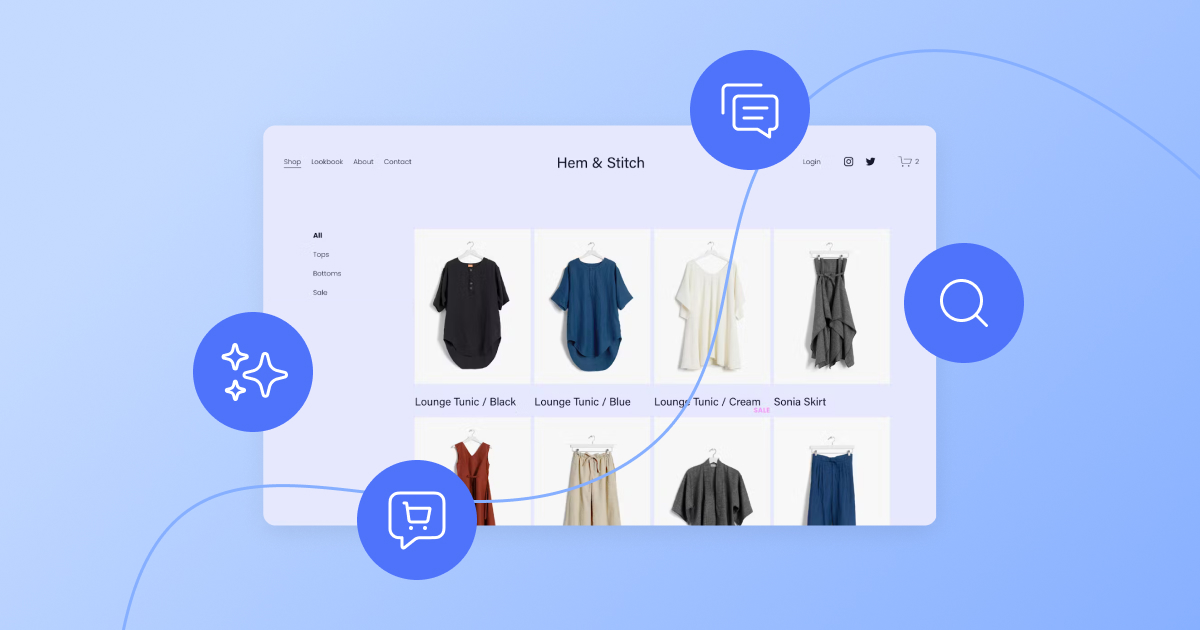A recent Walker ecommerce study reveals that by 2020, customer experience (CX) will emerge as a leading ecommerce brand differentiator.
Brands will have to differentiate themselves not based on price and product (as they have in the past), but rather on the experience that they provide to customers in both their physical and online retail stores.
Creating the exceptional customer experience needed to succeed in today’s competitive retail environment is only possible through relevant, memorable, and meaningful touchpoints delivered by omnichannel buying experiences.
Ecommerce is an essential component of any omnichannel approach and enhances the buying experience with its inherent convenience and ability to quickly adapt to consumer demands.
Natively digital, ecommerce offers a brand fluidity that a purely brick and mortar business cannot. Digital storefronts can be easily built with, and around tools that collect customer insights and data, arming ecommerce brands with the information needed to better serve their customers.
Not only has ecommerce made retail purchases more accessible, but it has also disrupted the traditional, linear, retail buyer’s journey and has transformed it into a more complicated series of touchpoints.
In order to succeed in this new world of omnichannel retail, brands need to make sure that they are providing exceptional customer experience during each stage of the buying process:
- Acquisition
- Shopping
- Post-purchase
- Ongoing customer engagement (pre and post-purchase)
Below, we explore each one of the above phases and examine what retailers can do to measure and enhance the customer experience.
Improving CX for the acquisition phase
Evidence shows that many consumers like to research products and brands online as the first step of their journey before making a purchase.
Retailers with a strong online presence can acquire more customers if their website is easily discoverable, simple to navigate, and — most importantly — mobile-friendly.
That last point is huge. If your site is not mobile-friendly, then you will not only lose customers, but you will create a negative brand image. To put this into perspective, let’s explore a few key statistics:
- 49% of consumers use their mobile phones to complete online purchases.
- A better screen resolution (i.e. get rid of those fuzzy product photos) will result in orders that are at least $1.18 higher in value.
- 61% of all U.S. consumers use mobile devices to compare prices when shopping at brick and mortar locations.
- 79% of U.S. adults have made an online purchase.
The last two statistics emphasize the importance of not only creating a mobile-friendly website, but also delivering a seamless experience between your online retail and physical stores. Improving your online presence is made easier with a few key strategies.
Improve site navigation
First, make sure your site’s search bar is easy to find and use. Don’t forget, consumers are typing on smaller devices and often using voice commands. If the search bar isn’t intuitive, then prospective customers will simply jump ship to your competitors.
Next, make sure that the top navigation is streamlined and leads to relevant pages. Nothing is worse than having to visit multiple pages on a mobile device just to find the product that you’re looking to purchase. A good rule of thumb is that consumers should be able to find the answers to their product searches in three clicks or fewer.
Support shoppers instantly with conversational commerce
If you are considering using a conversational ecommerce (i.e. live chat) feature, then make sure that it’s incorporated seamlessly onto your site and is simple to use. Most mobile users have pop-up ads blocked, which means that a site with a persistent live chatbot could be distracting to your customers or prevent them from navigating to the page they want.
One way around this potential challenge is to introduce the live chat as part of your Contact Us or Help pages. In the latter instances, consumers will be happy to discover that their answers can be immediately answered.
In fact, a recent study found that live chat (when used appropriately) had a consumer satisfaction rating of 92%. If you are on the fence about using live chat, then you can always test it, and pair it with a link survey to get customer feedback on the experience.
Collect website feedback
Web and in-app surveys are a great way to gather real-time feedback as customers are interacting with your website. Use Customer Effort Score (CES), Thumbs, or our customer satisfaction software to understand how well you’re helping customers fulfill their needs as they use your site.
Survey results can also factor into A/B split testing and conversion testing decisions as you implement new strategies to improve the browsing experience for your customers.
Increasing conversions during the shopping phase
So, what happens after a prospective customer successfully discovers your site? Chances are that after browsing for a while, they will fill, then abandon their virtual shopping cart.
In fact, Baymard reports the global average cart abandonment rate over the past 12 years is 70%. But why is that?
In Baymard’s same study, they found that the checkout experience – specifically the design and flow – was the top reason why users abandoned their online purchases. They also suggest with a better checkout experience, the average large ecommerce site can increase conversion by 35%.
To start evaluating the quality of the customer experience you provide, ask yourself the following:
- Is it easy for your customers to make a payment?
- If the customer has an account, is the payment information securely stored to expedite the checkout experience?
- Do you reassure customers regarding the security of their payments?
- Do you send reminder emails when a user signs out without emptying their shopping cart?
- Have you implemented discount strategies?
- Is it easy for customers to apply discount codes before they hit final checkout? In other words, do you entice customers by letting them know just how much they will save?
If you answered “no” to any of these questions, then you have a good starting point for improving the shopping experience to reduce cart abandonment.
Use customer feedback to improve the conversion process
If you answered “yes” to the questions above, but are still faced with a high percentage of abandoned shopping carts, then you might want to use a CES feedback survey.
A CES feedback survey is a great way to discover specific customer pain points. Ask them to rate how easy the checkout process was for them, and let them tell you why. Once you have more insights into the challenges that they face, you can more easily implement actionable solutions that create an improved experience.
Enhance the post-purchase support phase
Providing an excellent customer experience shouldn’t stop after a sale is completed. Customers want to receive purchase confirmation emails and notifications. They want to be alerted when their orders are packaged and shipped.
Finally, they want the reassurance that their packages have been delivered (which is exactly why Amazon Prime sends photo notifications of delivery to their consumers). In addition, customer support is essential for providing exceptional customer experience.
Customer support is arguably the most important aspect of the post-purchase phase. To enhance customer support, you can do the following:
- Have a 24/7 customer support team.
- Make it easy to contact your customer support team via phone, email, live chat, and even social media.
- Respond to social media posts that ask for support by directing them to the phone, email, or live chat services.
- Create self-serve support channels where customers can ask their fellow shoppers questions, post reviews, and create a community of loyal brand ambassadors.
The key to customer support is to remember that all it takes is one viral bad review to sink your company. If you feel like you are doing everything right, but still failing to produce the desired customer support results, then you can always use a customer feedback survey.
Collect support feedback with CES or CSAT surveys
Customer feedback surveys are a great way to understand what your customers expect after they have clicked the purchase button. Most importantly, surveys are a great way to show your customers that you care about improving your services, and delivering the optimal experience every time they consider purchasing a product.
CES and CSAT surveys are the two most-used survey types for improving support — you can read more about which type of survey to choose in our NPS vs CSAT vs CES guide.
Ongoing customer engagement
Ongoing customer engagement is the final component of the retail journey. Customers want to purchase from brands that produce rich, audience-focused content — preferably with a consistent message and story woven throughout.
Crafting your brand’s story is about more than coming up with a company mission and value statement. An effective story must instead focus on customers and ensuring that every consumer of your goods or services feels valued. Therefore, ecommerce retailers need to focus on creating personalized content that resonates with their customers or prospective customers both before and after a purchase is made.
Just as streaming platforms do a great job of recommending new movies to watch, so too should your ecommerce efforts create personalized suggestions for your customers. These personalized suggestions should include the content that you deliver to their inbox, the promotions that you send in-app, and the landing pages that they see when they log into your site.
At scale, this is no easy feat. Companies who do it well incorporate AI and machine learning into their marketing strategies. But, it all starts with understanding your customer, figuring out what their mindset is at each stage of the customer journey, and then building the systems necessary to deliver the right content at the right time.
Gain the insights needed to deliver the optimal ecommerce customer experience
The more time that customers spend shopping, the more they expect to have exceptional and personalized experiences. The good news is that Delighted can give you the insights that you need to create an integrated, personalized, and positive customer experience that increases sales, improves the lifetime value of your customers and produces loyal brand ambassadors.
Sign up for our experience management software to send surveys for free and discover the customer data that you need to create the optimal ecommerce customer experience.







